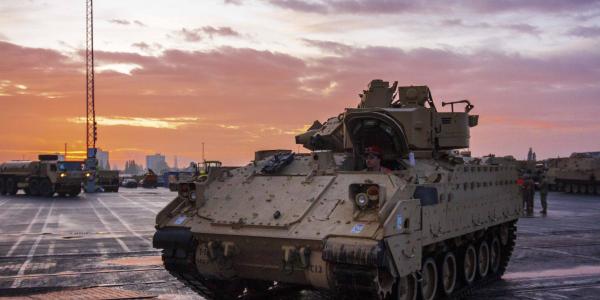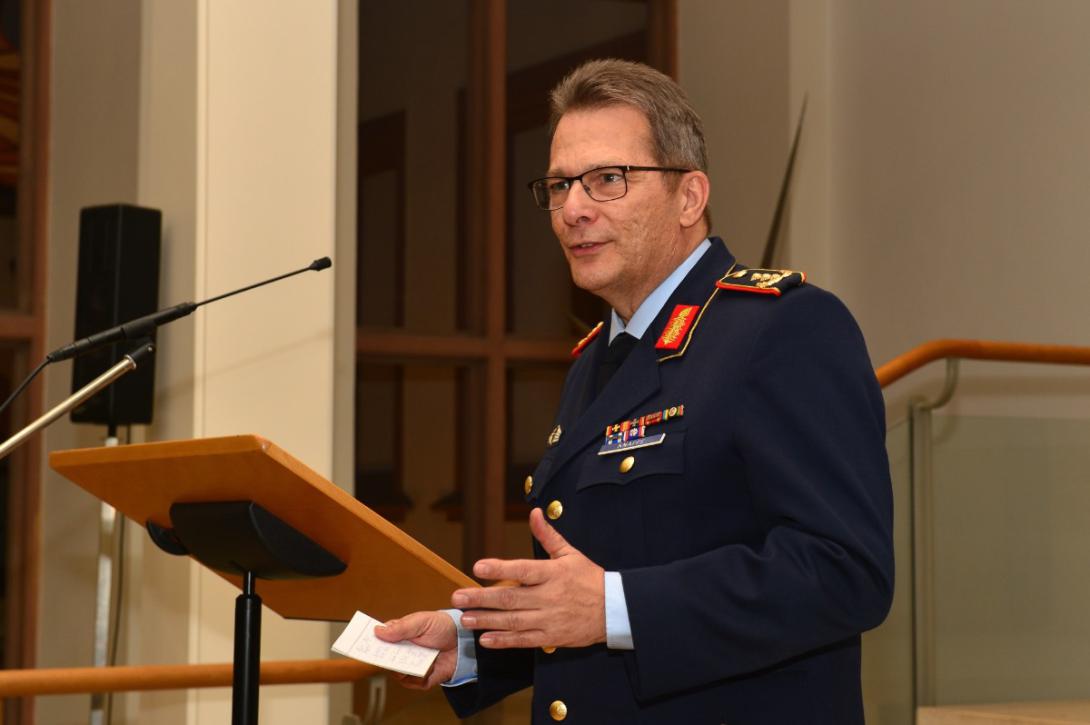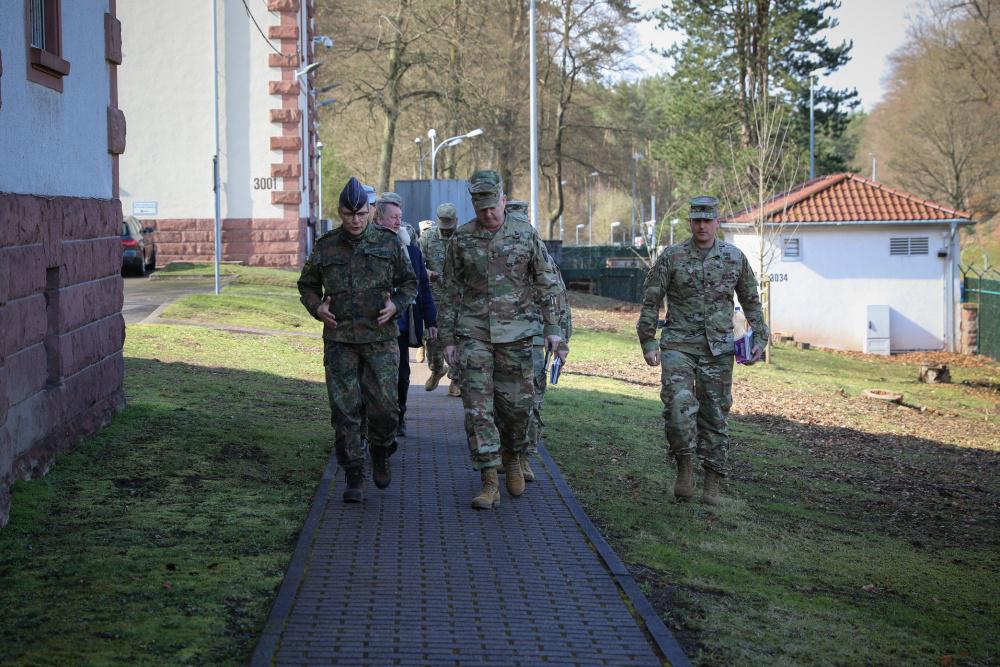NATO's New Coordinating Command Advances
NATO is evolving to adapt to present-day threats, and part of that strengthening means improving the deployment of forces to the European continent from allied nations. The organization’s new Joint Support and Enabling Command, known as JSEC, is taking on that role. The new command is in the process of building itself up, defining doctrine, forging relationships, and developing the necessary personnel and information technology infrastructure to support its operations.
“We must make it easier to deploy through Europe, not only for U.S. troops, but for British troops, Canadian troops, French troops, and others,” says JSEC’s commander, Lt. Gen. Jürgen Knappe, GEAF. “For SACEUR [Supreme Allied Commander Europe] it is necessary to have a coordinator. We are not only responsible for deployment, but [we] also [have] the responsibility to coordinate protection, to coordinate area damage control, to coordinate training and exercises.”
JSEC, as part of the new NATO Force Structure, is an operational-level international headquarters under SACEUR. The new command, located in Ulm, Germany, achieved initial operational capability last September, explains Gen. Knappe. Dual-hatted, Gen. Knappe also is the commanding general of the Multinational Joint Headquarters (JHQ), Ulm. The Multinational JHQ has played a key role in helping to build up JSEC.
In February 2018, NATO defense ministers voted to approve the establishment of two new commands—JSEC and the Joint Force Command (JFC) Norfolk—given the rise in threats coming from Russia. NATO “faces the greatest security challenges in a generation—including terrorism, cyber and hybrid threats and a more assertive Russia,” NATO Secretary-General Jens Stoltenberg stated at the time.
Germany volunteered to be the framework nation for JSEC, hosting the command in Ulm at the Wilhelmsburg barracks, while the United States agreed to host the JFC in Norfolk, Virginia, with the reestablishment of the U.S. Navy’s Second Fleet.
JFC Norfolk is responsible for NATO’s Atlantic sea operations, all the way up to the Arctic, and for protecting the undersea communications cables that connect Europe and North America. Meanwhile, NATO created JSEC to be the new support command for logistics, reinforcement and military mobility in order to improve the movement of troops and equipment on the European continent, which “is essential to our collective deterrence and defense,” said Stoltenberg. “It is about how to move forces across the Atlantic and how to move forces across Europe. This is vital for our transatlantic alliance.”
JFC Norfolk is led by the commander of the Second Fleet, Vice Adm. Andrew “Woody” Lewis, USN. JSEC is working closely with the Norfolk command and Adm. Lewis, Gen. Knappe explains. “We started our work together last year and we have a very close relationship with the Joint Force Command in Norfolk,” Gen. Knappe confirms. “We are the two new players in the NATO structure. We are both progressing towards full operational capability [FOC] in the same timeline, and we are coordinating our steps together. Our focus is to reach FOC in September 2021.”
While JFC Norfolk—as a NATO joint operational level command—is concerned with the security of the Atlantic, JSEC’s responsibility involves SACEUR’s rear area of operations, which could include the entire European mainland, depending upon NATO’s activities on the continent.
“I am responsible for the rear area, wherever the rear area is,” he states. “In our new NATO strategy and in our commitments with the secretary general, we have a 360-degree view. So, our focus is not only to the Eastern part of Europe, our focus is the 360-degree view. The rear area is in a close link with the operational area because the rear area is behind the operational area.”
The involved parties—SACEUR, JSEC’s troop contributing nations and other stakeholders—are ironing out a technical agreement of how they will work together, the general adds. “We have great support from SACEUR,” Gen. Knappe says. “Their team sees us as elements in their responsibility. When we are an international entity, we will be under the operational command of SACEUR, and Norfolk will be the same way. We are working as entities as if we are part of SACEUR Allied Command of Operations .”
Presently, the general’s JSEC development falls across four lines of effort: (1) defining and shaping the command’s conceptual work and doctrine; (2) engaging stakeholders and improving partnerships across its network of 29 NATO allies; (3) participating in military exercises; and (4) building up the infrastructure and developing the operations of the JSEC, including fielding personnel, computer information systems and financial platforms.
“The first line of focus is the conceptual work,” he says. “We are involved in all ways to shape and build up the concepts to make clear the role of the JSEC, [in conjunction with] JFC Norfolk and all the other entities. The second step is to build up the network with the nations, to make it clear that the JSEC is the new player, to take over the role as the coordinator for the security in the rear area for SACEUR and to build [relationships] with the NATO entities. The third step is to take part in the 2020 Defender Exercise, more or less in a learning role. And the fourth line of effort is to build up the JSEC.”
In building up the personnel for JSEC, the commander initially is relying on officials from the Multinational JHQ at Ulm. “I put 110 double-hatted members from the Multinational JHQ into the JSEC to push the JSEC in their build-up phase,” he shares. “At the moment, I have 18 members from 11 NATO nations in the JSEC. The point is the JSEC will become an international entity. At the moment, the JSEC is a German entity with some multinationals. But we have reached our first step, IOC, with a great rear area conference last September in Ulm, with a lot of interest from the different HQs of the 29 allies of NATO.”
With growing interest and awareness of the new command, however, comes greater responsibility amid the complex nature of moving thousands of troops and equipment in Europe for exercises—and a role that would differ in peacetime versus in times of war.
“We always have to develop bilateral agreements between the sending nations and the host nations, making contracts with the nations on how they will deploy their troops,” Gen. Knappe states. “But there are a lot of challenges given the different legal coordination and the different nation’s commitments on what you can actually do. Sometimes you are allowed to carry your weapons with you, and in other states you are not allowed to do it. You have restrictions in communications, and you have restrictions in route conditions, in how you can take the railway or certain roads. And you must communicate with civilian stakeholders, in certain countries where the government is hands-off, in order to rent railways or to rent planes when planning deployment. With each and every nation there is always a different set of conditions. My task is to make it easier to bring together all these stakeholders and to coordinate the different frameworks of sovereign nations.”
Moreover, JSEC follows the lead of SACEUR as it provides deployment assistance to the militaries of NATO nations. “I’m not in a commanding role,” the general clarifies. “I am in a coordinating role with the guidance of SACEUR, which means they must set priorities for all deployment questions, focusing on the operational area.” And as part of responding to SACEUR’s direction, JSEC must provide an operating picture of what is happening in the rear area.
“When I make a common operating picture for SACEUR, then I really need the support from all of the nations to give me their information to build up this common operating picture,” the commander emphasizes. “For Defender Europe, I worked together with leaders from Poland, Luxembourg, Germany, the Netherlands and Belgium. We are working out how they can support the JSEC and how JSEC can support the nations in the future.” JSEC also must provide awareness to SACEUR regarding the COVID-19 pandemic, and how it is affecting mobility, the commander notes. “When we speak about the COVID-19 pandemic, we have to look in the rear area, and that means we try to build up a common picture about the restrictions for military mobility in Europe,” he clarifies. “Because we know that the restrictions are different in the involved nations and so it is helpful for SACEUR to have a clear picture for their area of responsibility.
Additionally, the new command is putting together the necessary information technology, or computer information systems (CIS), needed to liaison with all involved entities, including how to coordinate across other systems, Gen. Knappe continued.
“When we speak about CIS, it is one of the most important things, because we have different players and every player has its own CIS system, and in the end, we must bring this together,” he specifies. “And it’s not only a military question. For example, when we speak about host nation support from Germany, there are civilian stakeholders in all of our 16 federal states of Germany. The police departments, for example, each have different systems or different authorities, and JSEC must bring all of these together. So, CIS and communications are one of the key points for us to fulfill our commitment.”
JSEC is also preparing to take part in the Defender 2022 exercise. Although the military is scaling back aspects of this year’s exercise due to the coronavirus, Gen. Knappe had already been planning to only participate in Defender 2020 in a learning role.
“Defender Europe 2020 was one year too early for me,” he notes. “It was planned and contracted before the JSEC was on the table. We are now in a standup phase or a build-up phase. We are not able with our personnel, with our concepts, with our network, to take part in the Defender Exercise in a leading role. But we know that our main duty in the future is to make the deployment of the troops of the Allies easier, and my focus is on the U.S. troops because they are our main customer. They are the main player to deploy troops to NATO. My duty is, and it is the U.S. expectation, that we will make the deployment of U.S. troops, and all allied troops through Europe, easier.”
To achieve full operational capability by September 2021, JSEC officials must successfully navigate a certification exercise, for which the command is also preparing. It encompasses training and deployment of troops, with the involvement of Norfolk, the general clarifies.
“The certification is fine, but it will not show in reality what we can do,” Gen. Knappe states. “Yes, we need the certification, but the real focus for 2022 is that we show the allies in the rear area that we are able to fulfill their expectations. We will show that we make deployment easier and quicker.”







Comments